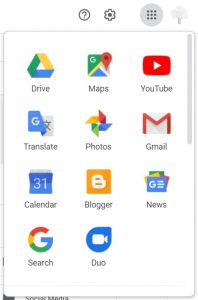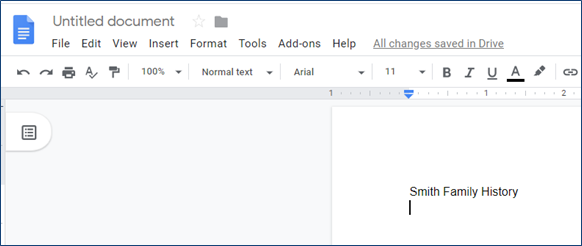Thank you to Lianne for this guest post and sharing her expertise with us. For more information on Lianne, see her bio below, or check out her blog here: iFamilyHistory.blogspot.ca.
1. How Can Google Drive Help With My Genealogy?
- Back-Up: All of your important genealogy files (such as documents, photos, and letters) should be in three locations: your computer, a USB drive, and somewhere online (that way, if something happens to one, you haven’t lost all your valuable documents!). Google Drive is a good location for the online component.
- Global Access: Google Drive allows you to access your genealogy files from anywhere, on any device, as long as you have an internet connection.
- Sharing: Google Drive allows you to share your genealogy files and photos with family members. You can give your family the ability to add information to the documents themselves, or simply just view them if you prefer to maintain control yourself.
2. How Do I Access Google Drive?
- If you have a Google e-mail, you already have Google Drive. If you don’t have one yet, you can easily create one here.
- Once your Google e-mail is set up, open your web browser.
- Type in Google.com.
- Log in to Google using the username and password setup when you created the account. Do not use the full Google email.
- In the top right of the page are 9 dots. This is a menu.
Click on the dots. - Select Google Drive.

3. How Do I Create a New Genealogy File in Google Drive?
If you want to write something within Google Drive, such as a family history or research log, take the following steps:
- From the main menu of Google Drive, click + New.

2. Select the program you want to use. For genealogical purposes, Google Docs is great for writing your family history, and Google Sheets is helpful if you are creating an inventory list or a research log. (If the program you want is not on the first list, simply click More, as shown in the image above).
3. Type your new document title at the top left of the screen.

4. Start writing down your genealogical data. Your document will be automatically saved every few minutes.
4. How Do I Upload Genealogy Files That Are Already On My Computer?
Some of your genealogy files may already be stored on your computer. You can easily upload these from your computer to your Google Drive by following the steps below:
1. Click New.
2. Click File upload.

3. Find the file on your computer and click upload. It will then be saved on your drive.

5. How Do I Create a Folder to Group Certain Genealogy Documents Together?
If you are working with multiple lines, it may be nice to group certain documents together in one place. To do so:
- Click New.

2. Click Folder.

3. The following window will then appear:

4. Type in the name for the folder.
(This name might be a last name for a specific line or a certain location, depending on what you are going to store and how you are grouping your items).
5. Click Create.
6. I’ve Uploaded Many Genealogy Documents. How Do I View All My Saved Files and Folders on Google Drive?
There are two ways to view files and folders: the view list and the grid list.
This is a view list:

This is a grid list:


You can choose which option works best for you.
Google Drive will also show you a “Recent List”. This is found above the grid or list views.

If you don’t like the recent list at the top, you can remove it by taking the following steps:
- Click on the gear icon in the top right corner of the screen.
- Click Settings.
- Make sure General is selected on the left.
- Scroll down (bar on the right) until you can see the section Suggestions.
- Click inside the box to remove the check mark for “Make relevant files handy when you need them in Quick Access.”
The Quick Access section will now no longer appear at the top.
You can still view this list at anytime after closing the list at the top with the following steps:
- On the main menu on the left, click Recent.

Recent files are listed in date categories such as Last week, Earlier this month, and Earlier this year.

7. Is It Possible to Search For A File By Name or Subject Matter?
Yes, it is. To find a file in your Google Drive:
- Click in the
Search box at the top of the screen.

2. Type in the name of a file or a phrase inside the file that you are looking for.
3. A list of files that have the text as a title or text inside that file will appear.

Conclusion
In conclusion, Google Drive can be extremely helpful for your genealogy research. In addition to giving you peace of mind with back-up options for your files, you can also easily share letters, photos, census records, newspaper clippings and more with your family and friends. Best yet, you can also access them yourself at any library, archive, or any place of your choosing.
Do you use Google Drive? Any tips for other users? Let us know in the comments!

Lianne began doing genealogy as a youth with family at graveyards, then as a teenager with a list of names in front of a microfilm reader on Saturdays at a Family History Library. At college she began researching her paternal grandmother’s line researching back to the first European landowners of Canada.
Lianne taught genealogical courses five years at LDS Institute in Ogden, Utah. She has spoken at genealogical conferences and sessions for RootsTech, Ontario Genealogical Society, The Genealogy Show (UK), FamilyRoots, Saskatchewan, and variety of locations in Alberta. Lianne has articles published by BYU Studies Quarterly magazine, FamilySearch.org, SK Translation, AGS Relatively Speaking and Tree Climber.
She has done webinars for The Surname Society, Virtual Genealogical Society, Red Deer Family History Fair, and a panelist for Looking 4 Ancestors.
She was President of Red Deer branch of Alberta Genealogical Society (AGS) for two years and Vice President of AGS for six years. She is now on the Ancestry.ca advisory committee and a member of the mitoYDNA board.
Lianne’s blog is iFamilyHistory.blogspot.ca.
Check out Lianne’s other popular guest post: How to Use Social Media in Your German Genealogy Research

12 Responses
Google Drive can be used to OCR & Translate
-copy jpg to Google Drive
-right click on jpg
-open with –> Google Docs
-Copy & Paste to Google Translate
this works with chinese characters and fraktur fonts
GoogleDrive automatically OCRs all items
GoogleDrive made names on pictures of tombstones searchable
Thank you so much for all the info, Gary – very helpful!
Trust but verify.
GoogleDrive’s autosync of your computer files to GoogleDrive doesn’t make a perfect backup.
I purchased a program that sets GoogleDrive as a drive that can worked with like it is a local drive.
I wrote some Excel macros to identify differences betweenGoogleDrive and my local computer files.
I need an automated method to check my 1+TB of GoogleDrive storage of almost 1 million items.
I had no idea Google Drive would do this. What a game changer! I just tested it with my parents’ divorce decree and it was amazing. A few tweaks had to be done but minor tweaks. Thank you so much for sharing that!
So happy to hear this, Cheryl! Gary is a tech wizard!
Thank you for the great post, Lianne. This is really helpful. I also appreciate the information that Gary Haas posted.
In Drive, I created a folder for each person in my tree, using the “SURNAME, FIRST NAME (born DATE)” title for each. If you upload a file to one person’s folder (eg a census record), you can share it with a second folder by right-clicking on the document and then choosing “Add shortcut to Drive” and selecting the 2nd folder title. That way, you only have to upload the doc once, but can have it in multiple locations. This is also helpful if you want to change the title of a document, as it will be updated in all locations if you change it in one place.
One issue this blog post does not really touch on is whether one should ever use Drive, or any other cloud-based storage, to host working files associated with genealogy software. E.g. I use Family Tree Maker 2019 to create trees (they sync with my Ancestry account), and GDAT (free database software) to map DNA segments back to common ancestors for the DNA kits I manage. In both cases the working database file lives on my laptop’s drive, not in the cloud, because it’s too easy to corrupt online databases due to minor connectivity lapses while the file is in use. Instead, copies of the dB backups are uploaded to Drive (and saved daily to my expernal backup device).
Regarding using cloud storage for important stuff
I have all my stuff on Google Drive
I have multiple copies in multiple locations
external drives, laptop drive, shared with other
Google Drive stores backup copies of stuff as you work on it
File revisions are only kept for up to 30 days.
No more than 100 file revisions are kept for any file
Being able to down load a previous version has saved my bacon numerous times
Since the original post, Google “switched” to GOOGLE DRIVE FOR DESKTOP
GOOGLE DRIVE FOR DESKTOP is an app you have on your local computer
GOOGLE DRIVE FOR DESKTOP is the greatest thing since sliced bread
You can access files on Google Drive using Windows Explorer
This lets you do tricks
– get a list of all files on Google Drive (you have to be tricky to get a list of MIRRORed files)
– you can easily download / backup all files to a local external drive (it can take for ever)
– you can access multiple Google Drive accounts
– you can create, copy, rename, move, delete Google Drive files/folders
– programs on your local PC uses your Google Drive files as though the file is on a local drive
The web version of Google Drive is clunky
But the web version of Google Drive is the only way to
search OCRed files on Google Drive
Google Drive stores backup copies of stuff as you work on it
File revisions are only kept for up to 30 days.
No more than 100 file revisions are kept for any file
Being able to down load a previous version has saved my bacon numerous times
Google Drive automatically OCRs all items. I have more than a thousand images in the old German handwritten script. Google Drive searches will find images with the surnames.
Google Sheets (Excel equivalent) has a nice feature to show you the history of a given cell, telling you what the previous value was, when it was changed, and by whom.
If you create a google group of family members, you can share a folder with the group, just enter the email address of the group. When you add a file to a folder, it inherits the sharing rights of the folder. So you only need to share the top folder and all files and subfolders will be shared.
For the programmer genealogists, Google Docs provides Google Apps Script, a powerful JavaScript language that can interact with Forms, Sheets, Docs, Sites, Gmail, etc.